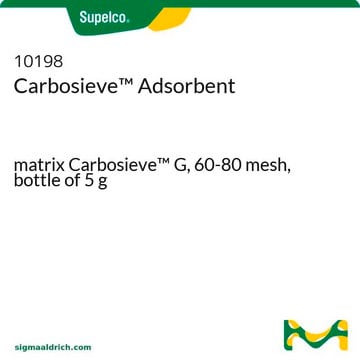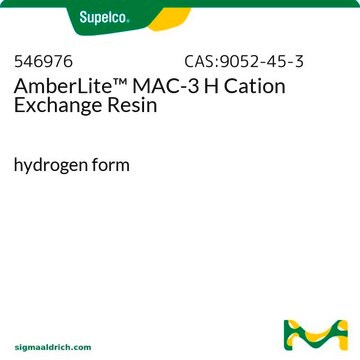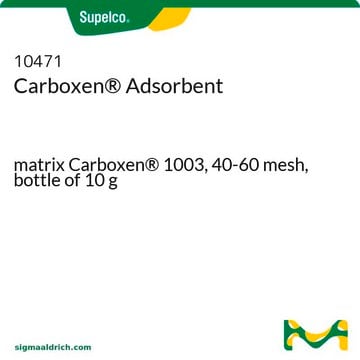10199
Carbosieve Carbon Adsorbent
matrix Carbosieve G, 80-100 mesh, bottle of 5 g
About This Item
Produtos recomendados
product name
Carbosieve Adsorbent, matrix Carbosieve G, 80-100 mesh, bottle of 5 g
linha de produto
Carbosieve
forma
powder or granules
embalagem
bottle of 5 g
técnica(s)
LPLC: suitable
gas chromatography (GC): suitable
solid phase extraction (SPE): suitable
área da superfície
~1160 m2/g
matriz
Carbosieve G
Grupo ativo da matriz
carbon
tamanho de partícula
80-100 mesh
tamanho de poro
~0.02 cm3/g mesoporosity
~0.49 cm3/g microporosity
~0 cm3/g macroporosity
~6-15 Å pore diameter
densidade
~0.27 g/mL (free fall density)
técnica de separação
reversed phase
Procurando produtos similares? Visita Guia de comparação de produtos
Categorias relacionadas
Descrição geral
- Spherical (better packed bed performance than granular particles)
- Hard and non-friable (pack well, will not break)
- Highly porous (high surface areas)
- Used for molecules with an analyte size relative to C2-C5 n-alkanes
- Hydrophobic (can be used in high humidity environments)
Generally, CMS adsorbents offer greater relative adsorptive strength compared to spherical graphitized polymer carbon (SGPC) and graphitized carbon black (GCB) adsorbents. Our Carbosieve products are a type of CMS adsorbent.
- Have non-tapered pores
- Very strong adsorptive strength due to only containing micropores
- Provide great performance for many small, volatile analytes that most adsorbents have trouble retaining
For more information about any of our specialty carbon adsorbents, please visit sigma-aldrich.com/carbon
Informações legais
Código de classe de armazenamento
11 - Combustible Solids
Classe de risco de água (WGK)
nwg
Ponto de fulgor (°F)
Not applicable
Ponto de fulgor (°C)
Not applicable
Equipamento de proteção individual
Eyeshields, Gloves, type P3 (EN 143) respirator cartridges
Choose from one of the most recent versions:
Certificados de análise (COA)
Sorry, we don't have COAs for this product available online at this time.
If you need assistance, please contact Atendimento ao cliente
Já possui este produto?
Encontre a documentação dos produtos que você adquiriu recentemente na biblioteca de documentos.
Nossa equipe de cientistas tem experiência em todas as áreas de pesquisa, incluindo Life Sciences, ciência de materiais, síntese química, cromatografia, química analítica e muitas outras.
Entre em contato com a assistência técnica






